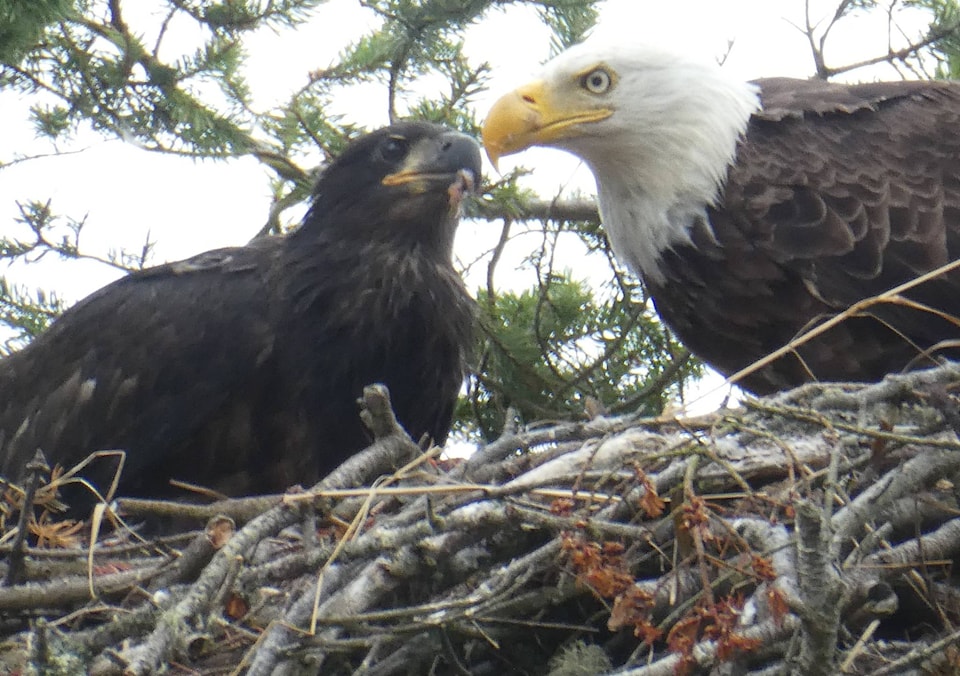A seaside home with a view is desirable to more than just humans.
That can also describe the ideal nesting sites for bald eagles. Unfortunately, it can be hard to make room for both humans and eagles along the waterfront, something the City of Campbell River has been attempting to reconcile with their bald eagle nesting tree development permit area.
The trees are identified to the city, which sends a biologist to collect data on the tree and potentially add it to a list of identified trees in the city.
“They have to have had a nest in the past, even if they don’t currently have a nest, they would still be designated bald eagle nest trees with the city,” explained Terri Martin, environmental specialist with the city.
After they’re identified, the trees are given a 60-metre buffer zone are placed on a publicly-available map of the community.
“The idea is is that no habitat is to be removed from that,” Martin said. “These development permit Areas, sometimes we talk about how they protect habitat. I want to be very cautious about that, because we do our best to protect the integrity of the nest tree, but the development permit process is a harm reduction measure. Generally, after development there’s less habitat there than there was before the development started, that’s just the way it is.”
“Our main goal is… to make sure that the construction itself doesn’t disturb nesting birds,” he added.
Recently a group of trees were cut down on a lot up for development near the shoreline in Campbell River. Neighbours voiced their concerns to the Mirror about the status of those trees and the fact that they had been used by eagles for perching. However, under the city’s official community plan (OCP), only trees that have been or are currently used by bald eagles for nesting are protected.
“I know the trees that you’re talking about, and I have no doubt that they were valuable trees on some level for perching,” Martin said. “Unfortunately, they are outside of any 60 metre development permit areas. There’s nothing I can do about that.”
“I wish I could,” he added.
The buffer is to the benefit of both the eagles and humans, since many eagle nesting trees are already damaged and can be a hazard to people down below.
“Bald eagle nest trees tend to be pretty big trees… they often already have a flaw, like a dead top, a thinning crown. That means that there may be a certain level of hazard associated with these trees… One of the things I want the biologist to do is look at what would happen if there was whole tree failure, if it just blew over in the wind with the root mass tipped up. We don’t want to see any targets within that falling distance area,” Martin said.
Currently, the map of bald eagle nesting trees is tied to the city’s OCP, which means that anytime there is a new tree added to the list there needs to be an amendment to the OCP. However, Martin said that they are moving towards separating the two documents, which would simplify the process of getting more trees added to the list.
Ultimately, the goal is to make it so people and eagles can live in the same space without infringing on each other’s territory.
“There’s about 30 breeding pairs in Campbell River and they’re territorial, so we can’t just jam them in one spot,” Martin said. “It helps developers by providing that information ahead of time. We have a pretty good handle on what trees are where… We’re liquidating nesting habitat pretty quickly. There are some concerns about that.”
“There’s a lot of competition for the marine shore,” he added.
RELATED: Campbell River’s great blue heron habitat protection process moves forward
Campbell River seeking eagle tree protection
marc.kitteringham@campbellrivermirror.com
Like us on Facebook and follow us on Twitter
